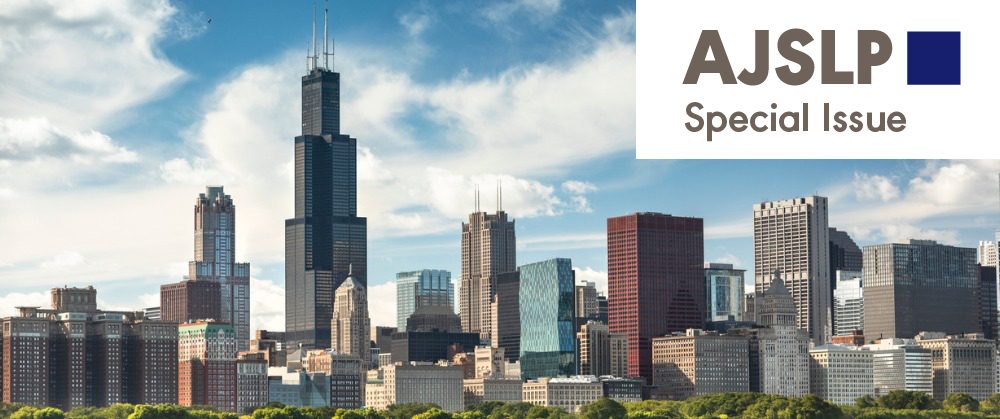The Charleston Swallowing Conference at Northwestern University is the largest multidisciplinary meeting of experts in dysphagia in the country. In the latest special issue from the American Journal of Speech-Language Pathology (AJSLP), special issue editors Bonnie Martin-Harris, Heather Shaw Bonilha, and Debra Suiter present 15 papers developed from the conference’s panel forums.
The Charleston Swallowing Conference has a unique goal: clinical application. Martin-Harris said presenters were asked to not only show where their work was going, but how it could influence patient care, and that each article’s focus is on “delivering evidence-based and practical methods to clinicians that come from the laboratory.” “Clinicians are looking for evidence to inform best practice,” Martin-Harris said. These authors also emphasize new technology-assisted methods and how to select, implement, and report on these methods.
One theme of the special issue is early detection of swallowing impairment in order to prevent further complications. Patients who are at a high risk of feeding and swallowing impairments can now be screened using high-tech and newly validated imaging systems. Additionally, there are still lessons to be learned from training, testing, and implementing traditional imaging methods clinicians may be more familiar with.
Another innovation discussed is the widespread use of electronic medical records and “big data” warehouses. Using these new resources, clinicians and researchers can work with other scientists to explore new hypotheses about swallowing function and severity, as well as refine existing theories and apply new discoveries to swallowing assessments.
A final theme of this collection is neurological control issues associated with swallowing, including the role of neuroplasticity in swallowing recovery and the use of electrical stimulation to directly affect the brain mechanisms controlling swallowing. This area of research is particularly relevant for patients who have neurodegenerative disease or have suffered a stroke.
We’d like to thank Martin-Harris, Bonilha, and Suiter for their work putting together this special issue. We echo their sentiments when they write, “We trust clinicians will gain practical, tangible, and directly translatable information toward advanced skill sets in swallowing assessment and treatment” (Martin Harris, Bonilha, & Suiter, 2020, p. 918).
You can see an interview with Martin-Harris about this unique special issue at the bottom of this post. Read the entire special issue here, or browse the individual articles under “Explore the Issue.”
References
Martin-Harris, B., Bonilha, H., & Suiter, D. (2020). Introduction to the special issue: Select papers from the 2018 Charleston Swallowing Conference at Northwestern University. American Journal of Speech-Language Pathology, 29(2S), 917–918. https://doi.org/10.1044/2020_AJSLP-20-00106
Explore the Issue
Bartolome, R., Kaneko-Tarui, T., Maron, J., & Zimmerman, E. (2020). The utility of speech-language biomarkers to predict oral feeding outcomes in the premature newborn. American Journal of Speech-Language Pathology, 29(2S), 1065–1077. https://doi.org/10.1044/2019_AJSLP-CSW18-19-0027
Beall, J., Hill, E. G., Armeson, K., Garand, K. L., Davidson, K., & Martin-Harris, B. (2020). Classification of physiologic swallowing impairment severity: A latent class analysis of modified barium swallow impairment profile scores. American Journal of Speech-Language Pathology, 29(2S), 1001–1011. https://doi.org/10.1044/2020_AJSLP-19-00080
Coyle, J. L., & Sejdić, E. (2020). High-resolution cervical auscultation and data science: New tools to address an old problem. American Journal of Speech-Language Pathology, 29(2S), 992–1000. https://doi.org/10.1044/2020_AJSLP-19-00155
Davidson, K., O’Rourke, A., Fortunato, J. E., & Jadcherla, S. (2020). The emerging importance of high-resolution manometry in the evaluation and treatment of deglutition in infants, children, and adults: New opportunities for speech-language pathologists. American Journal of Speech-Language Pathology, 29(2S), 945–955. https://doi.org/10.1044/2019_AJSLP-19-00067
Garand, K. L., McCullough, G., Crary, M., Arvedson, J. C., & Dodrill, P. (2020). Assessment across the lifespan: The clinical swallow evaluation. American Journal of Speech-Language Pathology, 29(2S), 919–933. https://doi.org/10.1044/2020_AJSLP-19-00063
Gosa, M. M., Dodrill, P., & Lefton-Greif, M. A., & Silverman, A. (2020). A multidisciplinary approach to pediatric feeding disorders: Roles of the speech-language pathologist and behavioral psychologist. American Journal of Speech-Language Pathology, 29(2S), 934–944. https://doi.org/10.1044/2020_AJSLP-19-00069
Gosa, M. M., Dodrill, P., & Robbins, J. (2020). Frontline interventions: Considerations for modifying fluids and foods for management of feeding and swallowing disorders across the life span. American Journal of Speech-Language Pathology, 29(2S), 956–966. https://doi.org/10.1044/2020_AJSLP-19-00065
Hopkins-Rossabi, T., Rowe, M., McGrattan, K., Rossabi, S., & Martin-Harris, B. (2020). Respiratory–swallow training methods: Accuracy of automated detection of swallow onset, respiratory phase, lung volume at swallow onset, and real-time performance feedback tested in healthy adults. American Journal of Speech-Language Pathology, 29(2S), 1012–1021. https://doi.org/10.1044/2020_AJSLP-19-00201
Martin-Harris, B., Bonilha, H., & Suiter, D. (2020). Introduction to the special issue: Select papers from the 2018 Charleston Swallowing Conference at Northwestern University. American Journal of Speech-Language Pathology, 29(2S), 917–918. https://doi.org/10.1044/2020_AJSLP-20-00106
Martin-Harris, B., Canon, C. L., Bonilha, H. S., Murray, J., Davidson, K., & Lefton-Greif, M. A. (2020). Best practices in modified barium swallow studies. American Journal of Speech-Language Pathology, 29(2S), 1078–1093. https://doi.org/10.1044/2020_AJSLP-19-00189
Miller, C. K., Schroeder, J. W., Jr., & Langmore, S. (2020). Fiberoptic endoscopic evaluation of swallowing across the age spectrum. American Journal of Speech-Language Pathology, 29(2S), 967–978. https://doi.org/10.1044/2019_AJSLP-19-00072
Rogus-Pulia, N. M., & Plowman, E. K. (2020). Shifting tides toward a proactive patient-centered approach in dysphagia management of neurodegenerative disease. American Journal of Speech-Language Pathology, 29(2S), 1094–1109. https://doi.org/10.1044/2020_AJSLP-19-00136
Sasegbon, A., Cheng, I., Zhang, M., & Hamdy, S. (2020). Advances in the use of neuromodulation for neurogenic dysphagia: Mechanisms and therapeutic application of pharyngeal electrical stimulation, transcranial magnetic stimulation, and transcranial direct current stimulation. American Journal of Speech-Language Pathology, 29(2S), 1044–1064. https://doi.org/10.1044/2020_AJSLP-19-00073
Suiter, D. M., Daniels, S. K., Barkmeier-Kraemer, J. M., & Silverman, A. H. (2020). Swallowing screening: Purposefully different from an assessment sensitivity and specificity related to clinical yield, interprofessional roles, and patient selection. American Journal of Speech-Language Pathology, 29(2S), 979–991. https://doi.org/10.1044/2020_AJSLP-19-00140
Wilmskoetter, J., Daniels, S. K., & Miller, A. J. (2020). Cortical and subcortical control of swallowing—Can we use information from lesion locations to improve diagnosis and treatment for patients with stroke? American Journal of Speech-Language Pathology, 29(2S), 1030–1043. https://doi.org/10.1044/2019_AJSLP-19-00068
Zimmerman, E., Carnaby, G., Lazarus, C. L., & Malandraki, G. A. (2020). Motor learning, neuroplasticity, strength and skill training: Moving from compensation to retraining in behavioral management of dysphagia. American Journal of Speech-Language Pathology, 29(2S), 1065–1077. https://doi.org/10.1044/2019_AJSLP-19-00088







